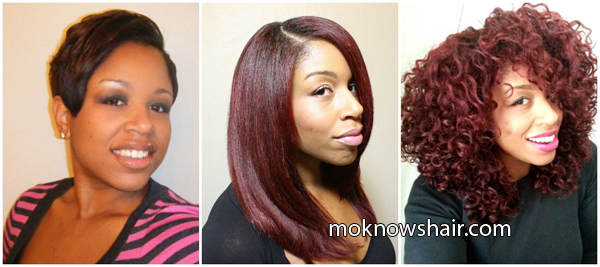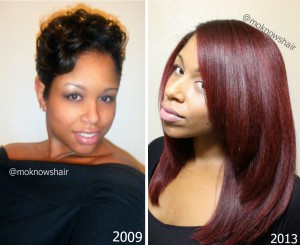
For many of us, long, luscious hair is the goal. After all the things we do to care for our hair, we want to see results in length and retain it. Before discussing how to retain length, we have to get on the same page about the difference between growth and retention.
Growth
There are three stages of growth, anagen, catagen and telogen, which occur simultaneously in different strands of hair. The average rate at which these phases make new hair is about .5 inches per month, or six inches a year. While growth rates vary per person, and can be dependent on other factors such as diet and medications you may be taking, your hair is growing. So when you say, “my hair isn’t growing, ” and I say, “yes it is,” here’s why:
In the anagen phase of growth, your follicles bury themselves in to the skin to nourish the new hair fibers being created. The longer this process takes the longer and faster hair grows. This phase is determined by genetics and supplemented with proper diet and internal health.
During the catagen phase, the follicle renews itself. Over the course of about two weeks it shrinks, cuts the hair off from the nourishment received in the anagen phase and forces the hair “out” causing the hair shaft to be pushed upward. This is known as “new growth.”
The telogen phase is where the follicle remains dormant for one to four months. At any given point, 10-15% of the hairs on your head are in this phase, which explains why you may have portions of hair that seem to grow faster than others. Once this time has passed, the anagen phase starts again.
There is a theory that everyone has a terminal growth point at which hair completely stops growing, however this is not yet supported with concrete, scientific evidence, so you can assume that your hair is always in the growth cycle. This is not to be confused with terminal length—the point at which hair seems to be unable to remain in tact without cutting due to breakage.
Because growth is genetically predetermined, you cannot physically alter the rate at which your hair grows, nor do you have control of its texture, color or density, but you can improve the health of the new strands and retain length so your growth is visible and your hair is healthy.
Length Retention

Length retention is the idea that you can do certain things to care for your hair that will prevent split ends and excessive breakage. When asked, “how do you get your hair to grow, Mo?” my answer is always, “it is about length retention, not growth…that’s genetic.” My hair grows at an average rate, but I don’t have lots of setbacks from breakage. Here are some things I do to retain my length, which results in the noticeable changes in length:
- I always deep condition my hair. This ensures proper amounts of moisture are installed in the hair shaft to endure all of the external elements and styling that will happen in the days after washing.
- I keep my scalp and hair clean. I find my hair sheds and breaks less when it is freshly cleansed and hydrated. I wash every five to seven days.
- No matter what, I always sleep in a satin/silk scarf or bonnet to protect my hair at night. And now that I have a satin pillowcase, I know the hair coming out of my pineapple is also protected as it rubs the pillow at night.
- I avoid styles that pull too tightly for too long of a period of time. This includes braids and sew-ins. I have had a few sew-ins a few years back, and tried braids in the past, but I don’t deem them solutions to healthy hair for me. This varies person to person, but constant pulling and tension tends to weaken hair and stress the scalp. And use of synthetic fibers/hair can cause excessive dryness and damaging friction. As always, it’s about balance.
- I do wash-n-go’s mainly and the occasional blow-out and flat iron straightening once or twice a year. My hair doesn’t react negatively to heat because I always use ceramic tools, heat protectants and make sure to mix heat with non-heat styling.
- I trim my ends only as needed. About four times a year I will trim the standard .8 of an inch unless there’s a section that needs more trimming. This keeps ends from splitting further up the strands causing large amounts of breakage. Some people can trim once a year while others need it every 8-10 weeks. You have to determine what is best for your hair.
- I drink lots of water (about a gallon), every day. You should be consuming at least half of your body weight in ounces of water. This keeps your body hydrated and in turn causes you hair and skin to be more balanced in moisture.
- I always use a wide tooth shower comb to detangle my hair when wet, then I may use a finer tooth comb or brush for further smoothing if necessary.
- I use an elasticity treatment each washday to keep my protein-moisture levels balanced.
- I eat lots of protein, veggies and foods with antioxidants. What you put in your body contributes to the production of the hair in the anagen phase of growth. The more nutrients you consume, the better that phase will be, resulting in longer, healthier strands.
- I replace my brushes, combs, metal and butterfly clips every six months (or less if needed) and clean them every couple weeks or so. If you have been using the same tools for years, you are likely snagging and tearing away strands of hair unnecessarily with your boar brush whose bristles are matted, leaning and split. It’s not just about the products you use, the tools are important too. Keep your tools clean and remember to replace them!
- I stick to a routine. Consistency is key for healthy hair. Just like you need a schedule and routine to successfully conquer your day, your hair needs a routine to get adjusted to and flourish in. Once you find what works, make it a point to stick to it for at least a couple months before switching this for that…give your hair a chance to respond!
For me, there’s no magic, no pills, no secret products not available to the general public; it’s just consistency and dedication to proper care. When it comes to length retention, less manipulation is always best. Maintaining a balanced diet, using the right products for your hair and finding a solid regimen that works and sticking to it are essential to success in retention.
Make it a point to hold yourself accountable for your hair care and not skip treatment weeks or cut corners when you don’t “feel like it.” And if you feel like you are suffering from a scalp condition or other disorder, don’t allow it to fester, get help from a dermatologist or hair loss specialist. While growth is genetic, how your hair looks and how much of it you retain is up to you.

Great post and your hair looks amazing. Thanks for sharing these helpful tips.
I looooove that!
excellent post. I am going to share on my FB page
Thanks for this post. I relax my hair and it is quite long and healthy but I recently suffered a setback and my hair has lost thickness. Your post is a very handy reminder of what to do.
Another tip. Be patient.
Hi, I just want to let you know your hair is beautiful. I appreciate you putting a before picture and letting us all know the time frame. I have been transistioning for 5 months now. I’m at the point where my crown area is growing faster than the rest of my hair but it is also drying out the quickest also. I cut most of my hair because of damaged ends and sometimes I don’t know what to do with it. You among other women on YouTube are definitely helping me thru this difficult time. Thanks!!
Mo I love your blog. What is your opinion on hair and skin vitamins?
I don’t use them, and I definitely recommend anyone considering them to talk to their doc/derma first.
Good Job.